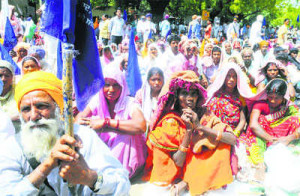A new Dalit assertion is round the corner
 Sangrur:A beginning has been made. With 32 per cent population share, the highest among developed states, Dalits have started asserting themselves in Punjab. A movement has begun to take shape in the countryside, where they have been living on the margins.
Sangrur:A beginning has been made. With 32 per cent population share, the highest among developed states, Dalits have started asserting themselves in Punjab. A movement has begun to take shape in the countryside, where they have been living on the margins.
It is difficult to gauge what momentum it will gain in the days to come but Sangrur’s example certainly has the potential to take roots. Reason: It has not only produced an amazing success story but opened up opportunities for a new in Punjab’s predominantly agriculture-based rural economy.
The first seed of the movement was sown at Malwa region’s Balad Kalan village in Sangrur district, where Dalits strived hard for about a year to win their legal right to till panchayat land. Yielding to the resolve and persisting struggle launched by 132 Dalit families in the village, the Panchayats Department has handed over about 84 acres of Panchayat land to them on lease for the current fiscal year (2015-16).
The successful endeavour to secure land on lease just turned out to be a medium for Dalits to unite at one platform. A surprising element is this is the first time the Malwa region is witnessing such a development among Dalits. Otherwise, Doaba is known as a stronghold of Dalits, especially in Hoshiarpur, Nawanshahr and Jalandhar districts, where the Dalit population is close to 40 per cent. In Malwa, Faridkot and Muktsar have a similarly high percentage of Dalits. “Various Government schemes for the so-called welfare of Dalits have not been reaching them. At the social level, there has been discrimination with them at all levels because of the pronounced problem of untouchability and casteism”, says a Dalit activist involved in the movement.
For how long the community would continue to suffer was the question bothering the young Dalit brigade for quite some time. Dalits have been facing oppression since ages but their exclusion at the social level, especially in rural areas, is quite evident. The land controversy at Balad Kalan provided them a legitimate opportunity to fight for their rights. Connected to land are other issues such as social prejudices faced by the community. “The younger generation of Dalits is not prepared to tolerate discrimination. Our elders have suffered a lot but we are not prepared to take such humiliation in our stride”, says Dalit activist Umesh.
Though the Panchayat Department is duty bound to give at least one-third of panchayat lands to Dalits on lease, mischief was being played at the official level in connivance with influential people in the villages. Well-off people used to take the share of Dalits in panchayat land, creating dummy parties when offering bids for it. To counter this phenomenon, Dalits formed a “Zameen Prapati Sangarsh Committee” (A committee to struggle to take the land) last year.
After a long struggle, which turned violent at times, leading to the registration of criminal cases and even arrests of Dalit activists, the district administration finally agreed to lease land only for the Rabi crop, which means for only six months. But this year, it has been leased out to Dalits for the entire year.
Another encouraging development is their tilt towards cooperative farming, which, if replicated, could bring about far-reaching changes in the pattern of agriculture in the state.
When they got the land for growing Rabi crops last year, the 132 Dalit families pooled together Rs 14.99 lakh, some as loan from commission agents and others, as lease money. They also collected an additional Rs 11 lakh to nurse the crop. The outcome of this collective effort was 2,500 quintals of wheat. Each shareholder family was given two quintals of wheat and one full trolley of wheat chaff, besides green fodder for six months as a share from the divisible proceeds. The remaining wheat was sold in the market for Rs 24 lakh. “Our total expenditure on taking the land on lease and growing crops etc was Rs 26.50 lakh. We have repaid the loan after selling the surplus wheat in the market. Besides, each family got wheat, chaff and green fodder”, says Bhag Singh, a member of the Committee. “Though last year we were allowed to grow only one crop, we earned money by doing collective farming which saved lot of money in various ways. This year, we will be growing two crops and will certainly earn good sum if nature does not play the villain. Moreover, the lease amount is 10 per cent less compared to the last year,” he adds. Meanwhile, the Zameen Prapati Sangharsh Committee has spread its wings in almost the entire Sangrur district and some villages of adjoining Patiala district. The other important development is the Committee’s backing to the cause of non-Dalit small and marginal farmers who have been pushed to the edge due to rapid increase in agricultural related inputs. “We feel the pain and problems being encountered by non-Dalit small and marginal farmers and are making an effort to take them along”, asserts Mukesh. Interestingly, the large Dalit population has never been a dominant player in state politics but determines which party should come to power. For decades, Dalits stood by the Congress. With the rise of the Bahujan Samaj Party (BSP) in the 1990s, they gravitated towards it. The founder and builder of the BSP, the late Kanshi Ram belonged to Punjab. Following the decline of the BSP, Dalits, by and large, turned towards the SAD for the past some years. No one can guess at this stage as to what will happen next. However, with the assertion of Dalits in the politically significant Malwa region, there can be a decisive shift in the state’s politics during the next Assembly election.
Source: The Tribune





